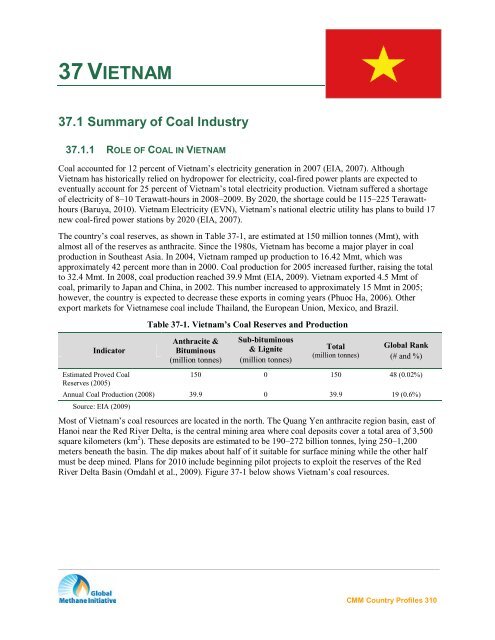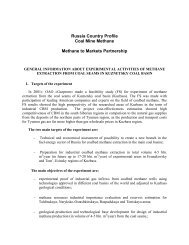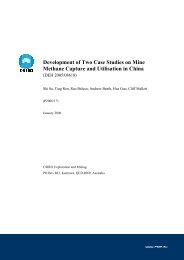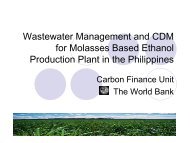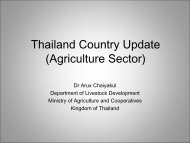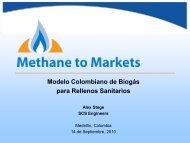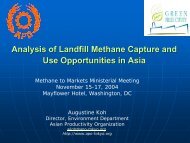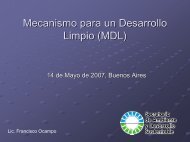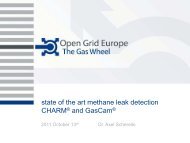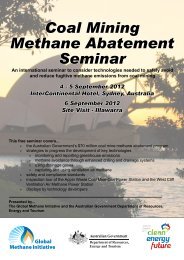Coal Mine Methane Country Profiles - Global Methane Initiative
Coal Mine Methane Country Profiles - Global Methane Initiative
Coal Mine Methane Country Profiles - Global Methane Initiative
You also want an ePaper? Increase the reach of your titles
YUMPU automatically turns print PDFs into web optimized ePapers that Google loves.
37 VIETNAM<br />
37.1 Summary of <strong>Coal</strong> Industry<br />
37.1.1 ROLE OF COAL IN VIETNAM<br />
<strong>Coal</strong> accounted for 12 percent of Vietnam’s electricity generation in 2007 (EIA, 2007). Although<br />
Vietnam has historically relied on hydropower for electricity, coal-fired power plants are expected to<br />
eventually account for 25 percent of Vietnam’s total electricity production. Vietnam suffered a shortage<br />
of electricity of 8–10 Terawatt-hours in 2008–2009. By 2020, the shortage could be 115–225 Terawatthours<br />
(Baruya, 2010). Vietnam Electricity (EVN), Vietnam’s national electric utility has plans to build 17<br />
new coal-fired power stations by 2020 (EIA, 2007).<br />
The country’s coal reserves, as shown in Table 37-1, are estimated at 150 million tonnes (Mmt), with<br />
almost all of the reserves as anthracite. Since the 1980s, Vietnam has become a major player in coal<br />
production in Southeast Asia. In 2004, Vietnam ramped up production to 16.42 Mmt, which was<br />
approximately 42 percent more than in 2000. <strong>Coal</strong> production for 2005 increased further, raising the total<br />
to 32.4 Mmt. In 2008, coal production reached 39.9 Mmt (EIA, 2009). Vietnam exported 4.5 Mmt of<br />
coal, primarily to Japan and China, in 2002. This number increased to approximately 15 Mmt in 2005;<br />
however, the country is expected to decrease these exports in coming years (Phuoc Ha, 2006). Other<br />
export markets for Vietnamese coal include Thailand, the European Union, Mexico, and Brazil.<br />
Table 37-1. Vietnam’s <strong>Coal</strong> Reserves and Production<br />
Indicator<br />
Anthracite &<br />
Bituminous<br />
(million tonnes)<br />
Sub-bituminous<br />
& Lignite<br />
(million tonnes)<br />
Total<br />
(million tonnes)<br />
<strong>Global</strong> Rank<br />
(# and %)<br />
Estimated Proved <strong>Coal</strong><br />
150 0 150 48 (0.02%)<br />
Reserves (2005)<br />
Annual <strong>Coal</strong> Production (2008) 39.9 0 39.9 19 (0.6%)<br />
Source: EIA (2009)<br />
Most of Vietnam’s coal resources are located in the north. The Quang Yen anthracite region basin, east of<br />
Hanoi near the Red River Delta, is the central mining area where coal deposits cover a total area of 3,500<br />
square kilometers (km 2 ). These deposits are estimated to be 190–272 billion tonnes, lying 250–1,200<br />
meters beneath the basin. The dip makes about half of it suitable for surface mining while the other half<br />
must be deep mined. Plans for 2010 include beginning pilot projects to exploit the reserves of the Red<br />
River Delta Basin (Omdahl et al., 2009). Figure 37-1 below shows Vietnam’s coal resources.<br />
CMM <strong>Country</strong> <strong>Profiles</strong> 310
VIETNAM<br />
Figure 37-1. Vietnam’s <strong>Coal</strong> Resources<br />
Source: Baruya (2010)<br />
CMM <strong>Country</strong> <strong>Profiles</strong> 311
VIETNAM<br />
37.1.2 STAKEHOLDERS<br />
Vietnam’s coal mining industry is owned and operated by the state coal mining company, Vinacomin<br />
(Vietnam National <strong>Coal</strong> and <strong>Mine</strong>ral Industries Group), which was created by the merger of the Vietnam<br />
<strong>Coal</strong> Corporation (Vinacoal) and Vietnam <strong>Mine</strong>rals Corporation. Vinacomin operates 100 percent of all<br />
coal mines.<br />
Table 37-2. Key Stakeholders in Vietnam’s CMM Industry<br />
Stakeholder Category Stakeholder Role<br />
Mining companies • Vinacoal Project hosts<br />
Equipment Manufacturers • Vietnam Research Institute of Electronics, Informatics and<br />
Automation<br />
Universities, Research<br />
Establishments<br />
• Institute of Mining Science and Technology, Hanoi,<br />
Vietnam<br />
• University of Mining and Geology, Hanoi, Vietnam<br />
Technical assistance<br />
Regulatory Agencies and<br />
Government Groups<br />
• Vinacoal<br />
• PetroVietnam<br />
• PetroVietnam Exploration Production Corporation<br />
37.1.3 STATUS OF COAL AND THE COAL MINING INDUSTRY<br />
Project identification<br />
and assessment support<br />
<strong>Coal</strong> production from underground mines in past years has reached 30–35 percent of capacity and will<br />
increase in the coming years. As of 2009, Vietnam had 20 underground mines, seven of which have an<br />
annual production capacity of more than 1 Mmt. The remaining underground mines have an annual<br />
capacity between 300,000 and 800,000 tonnes per mine (Omdahl et. al., 2009). Vietnam is seeking to<br />
increase production of its deeper anthracite reserves for high-quality export grade coals, as well as for its<br />
expanding coal power sector. Purchases of heavy mining equipment from Australia have enabled the<br />
expansion of existing underground mines and development of new underground mines.<br />
Some of Vietnam’s surface mines have been closed; however, 29 remain open. Six surface mines have an<br />
annual production capacity from 0.8 to 1.5 Mmt per mine. The remaining mines each have an annual<br />
capacity of 200,000–400,000 tonnes (Omdahl et.al., 2009).<br />
As of 2008, Vietnam had 27 total thermal power plants, 10 of which are coal-fired and 13 are gas-fired.<br />
<strong>Coal</strong>-fired plants include Na Duong (110 megawatts [MW]), Cao Ngan (110 MW), Cam Pha (two 340-<br />
MW) and Son Dong (220 MW). Vietnam has plans to build an additional 12 thermal power plants in the<br />
northern economic regions by 2015. <strong>Coal</strong>-fired plants currently under construction include Mao Khe (220<br />
MW) and Nong Son (30 MW). Vietnam plans to import coal to meet power demand after 2011 (Omdahl<br />
et. al., 2009).<br />
37.2 Overview of CMM Emissions and Development Potential<br />
The <strong>Global</strong> <strong>Methane</strong> <strong>Initiative</strong> (formerly <strong>Methane</strong> to Markets Partnership) International CMM Projects<br />
Database currently identifies no CMM projects; however, the coalbed methane (CBM) industry is<br />
emerging in areas where mining is poised to take place, and thus may evolve into CMM projects as CBM<br />
activity intersects with mining.<br />
A recent study of Vietnam’s 25 gassy hard coal mines was commissioned to determine gas content of<br />
coals and to forecast methane release into the mines. Seven mines were classified as especially gassy. The<br />
CMM <strong>Country</strong> <strong>Profiles</strong> 312
VIETNAM<br />
results of the forecasts and a study of the capacities of these mines’ ventilation systems are being used to<br />
estimate the amount of methane that may be captured by drainage systems. Additionally, the gassiest<br />
mine, Mao Khe, was equipped with an automatic methane content measurement control system (Somers,<br />
2010).<br />
37.2.1 CMM EMISSIONS FROM OPERATING MINES<br />
With increasing coal production and the mining of deeper seams, CMM emissions in Vietnam have also<br />
increased. Table 37-3 summarizes Vietnam’s CMM emissions.<br />
Table 37-3. Vietnam’s CMM Emissions (million cubic meters)<br />
Emission Category 1990 1994 1995 2000 2005 2010<br />
(projected)<br />
Total Emissions from Underground <strong>Coal</strong> <strong>Mine</strong>s 49.80<br />
Total Emissions from Surface <strong>Mine</strong>s 3.18<br />
Total liberated 52.98<br />
Recovered & Used 0<br />
Total emitted 32.4* 52.98 58.5* 69.7* 83.2* 99.3*<br />
Source: UNFCCC (2003); *USEPA (2006)<br />
37.2.2 CMM EMISSIONS FROM ABANDONED MINES<br />
No information relating to recovery or use of CMM from abandoned mines was found.<br />
37.2.3 CBM FROM VIRGIN COAL SEAMS<br />
A number of potential areas for CBM development exist in Vietnam. The Red River Basin is an<br />
economically important area of northern Vietnam. The area has coal deposits lying at depths of 250–<br />
1,200 meters spread over a 3,500 km 2 area. Gas content of the basin’s sub-bituminous coal is estimated at<br />
0.94–1.6 m 3 per tonne (30–50 standard cubic feet [scf]/ton), with conservative resource estimates ranging<br />
from 170 to 280 billion m 3 (6–10 trillion cubic feet [Tcf]). Another area of interest is the Quang Yen<br />
Basin, which extends over 200 kilometers (km) from east to west in northeast Vietnam and covers<br />
approximately 5,000 km 2 . Though yet undetermined, CBM and CMM potential of this area is a target for<br />
study (Thai, 2008).<br />
Most of Vietnam’s CBM activity to date has been confined to the Red River Basin. Keeper Resources has<br />
been working on the first CBM extraction projects. The negotiated CBM concession with PetroVietnam<br />
and PetroVietnam Exploration Production Corporation (PVEP) covers approximately 3,600 km 2 of the<br />
Red River Basin to the southeast of Hanoi. Three years of negotiations were concluded with the signing<br />
of a CBM Production Sharing Contract (PSC) in early 2010. The project proceeded with the signing of<br />
drill site construction and preparation contracts after acquiring land access approvals (Dragon Capital,<br />
2008; Dragon Capital, 2010). A scoping study of the CBM potential in the Red River Basin<br />
commissioned by Keeper estimated prospective gas resources to be 55 billion m 3 in the study area, which<br />
represents 28 percent of Keeper’s concession (Keeper, 2005).<br />
In addition, Arrow Energy has signed a PSC with PVEP in a CBM concession of 2,743 km 2 in the Red<br />
River Basin. The PSC requires Arrow to drill eight wells on the block. Exploration drilling began in<br />
January 2009 (Arrow, 2009).<br />
CMM <strong>Country</strong> <strong>Profiles</strong> 313
VIETNAM<br />
37.3 Opportunities and Challenges to Greater CMM Recovery<br />
and Use<br />
Vietnam is a signatory to both the UNFCCC and the Kyoto Protocol (see Table 37-40). As a Non-Annex I<br />
Party to the Kyoto Protocol, it has no national emissions targets and is eligible to host mitigation projects<br />
under the Clean Development Mechanism.<br />
Table 37-4. Vietnam’s Climate Change Mitigation Commitment<br />
Agreement Signature Ratification<br />
UNFCCC June 11, 1992 November 16, 1994<br />
Kyoto Protocol December 3, 1998 September 25, 2002<br />
Source: UNFCCC (2010)<br />
37.3.1 MARKET AND INFRASTRUCTURE FACTORS<br />
No information pertaining to market and infrastructure barriers could be sourced from the Vietnamese<br />
Ministry of Natural Resources and Environment website or the Ministry of Industry and Trade’s website,<br />
as of June 2010. However steady and increasing coal mining as well as increased demand for natural gas<br />
makes CBM and CMM attractive in Vietnam. <strong>Coal</strong> mining is poised to continue escalating in Vietnam to<br />
meet the demand of 200 Mmt by 2020 (MONRE, 2010a). There have also been recent discussions within<br />
the country surrounding the use of natural gas to fuel additional power plants as well as the use of natural<br />
gas in the form of compressed natural gas (CNG) to operate vehicles (MONRE, 2010b; MONRE, 2010c).<br />
Between 2008 and the first half of 2009, Vietnam commissioned 5 GWe of new electric capacity, much<br />
of which was gas-fired (2.7 GWe) (Baruya, 2010). Currently, natural gas is not commonly used outside of<br />
the industrial and power generation sectors (EIA, 2007).<br />
37.3.2 REGULATORY INFORMATION<br />
Vietnam’s natural gas sector is dominated by the state-owned Vietnam Oil & Gas Corporation,<br />
Petrovietnam, which is under the control of the Ministry of Industry (EIA, 2007). Current CBM activity is<br />
conducted through production sharing contracts.<br />
<strong>Coal</strong> production in Vietnam exceeded growth expectations from 2001 to 2005. Various sources have<br />
reported that the Vietnamese government would like to slow this growth and retain coal reserves for<br />
domestic utilization.<br />
37.4 <strong>Profiles</strong> of Individual <strong>Mine</strong>s<br />
The Vietnam <strong>Coal</strong> Corporation reports coal reserves of 6.5–7 billion tonnes in the Quang Nimh coalmine<br />
(Phuoc Ha, 2006); however no information regarding CMM projects could be obtained. Updates on future<br />
CMM projects in Vietnam can be found at<br />
http://www.methanetomarkets.org/coalmines/index.htm#profiles.<br />
37.5 References<br />
Arrow (2009): Vietnam – Arrow Energy. http://www.arrowenergy.com.au/page/Projects/Vietnam/<br />
CMM <strong>Country</strong> <strong>Profiles</strong> 314
VIETNAM<br />
Baruya (2010): Prospects for <strong>Coal</strong> in Vietnam. Paul Baruya, IEA Clean <strong>Coal</strong> Centre. CCC/164, ISBN 978-92-9029-<br />
484-9, February 2010. http://www.iea-coal.org.uk/site/ieacoal/publications/newsletter/current-issue/prospectsfor-coal-in-vietnam<br />
Dragon Capital (2008). Vietnam Resource Investments. Dragon Capital Markets Limited Monthly Report March<br />
2008. http://www.dragoncapital.com/UserFiles/File/monthly%20report/2008/Mar/MR_200803VRI.pdf?PHP<br />
SESSID=e1fc9daa1d3bfa3ae589ab41f43ad982<br />
Dragon Capital (2010): Vietnam January 2010 Update. Dragon Capital Markets Limited. January, 2010.<br />
http://www.dragoncapital.com/UserFiles/File/monthly%20report/2010/Jan/MR_201001.pdf<br />
EIA (2007): Vietnam <strong>Country</strong> Analysis Brief, U.S. Energy Information Administration, July 2007.<br />
http://www.eia.doe.gov/emeu/cabs/Vietnam/Full.html<br />
EIA (2009): International Energy Statistics. U.S. Energy Information Administration, Independent Statistics and<br />
Analysis. 2009. http://tonto.eia.doe.gov/cfapps/ipdbproject/IEDIndex3.cfm<br />
IEA (2007): International Energy Agency Energy Statistics – <strong>Coal</strong>. International Energy Agency, Paris, France,<br />
table posted at http://www.iea.org/Textbase/country/index.asp<br />
IEA <strong>Coal</strong> Research (1983): Concise Guide to World <strong>Coal</strong>fields, IEA <strong>Coal</strong> Research, London, 1983.<br />
Keeper (2005): Vietnam CBM Review. Keeper Resources. 2005.<br />
http://www.keeperresources.com/Vietnam%20CBM%20Review.pdf<br />
MONRE (2010a): <strong>Coal</strong> sector urged to ensure occupational health and safety. Viet Nam Ministry of Natural<br />
Resources and Environment. January 25, 2010.<br />
http://www.monre.gov.vn/monreNet/Default.aspx?tabid=256&ItemID=79305<br />
MONRE (2010b): US offers to help Vietnam exploit gas reserves. Viet Nam Ministry of Natural Resources and<br />
Environment. March 19, 2010. http://www.monre.gov.vn/monreNet/Default.aspx?tabid=256&ItemID=81570<br />
MONRE (2010c): Greater government support needed for natural gas. Viet Nam Ministry of Natural Resources and<br />
Environment. April 2, 2010. http://www.monre.gov.vn/monreNet/Default.aspx?tabid=259&ItemID=82302<br />
Omdahl et. al. (2009):Vietnam’s <strong>Coal</strong>, Mining, and <strong>Coal</strong>-fired Power Generation. Brent Omdahl, Nguyen Dzung,<br />
and Jason Card, U.S. Embassy Hanoi, Vietnam, presented June 10, 2009, available from United States<br />
Commercial Service, United States Department of Commerce. http://www.buyusa.gov/vietnam/en/259.html<br />
Phuoc Ha (2006): Vetnamnet Bridge. http://english.vietnamnet.vn/biz/2006/09/608994/<br />
Somers (2010): <strong>Coal</strong> <strong>Mine</strong> <strong>Methane</strong> Project Opportunities: <strong>Global</strong>ly and in Viet Nam, Jayne Somers and Charlee<br />
Boger, presented at Advanced Mining for Sustainable Development, Ha Long Bay, Viet Nam September, 2010.<br />
Thai (2008): <strong>Coal</strong> Bed <strong>Methane</strong> in Vietnam is Hot. Thai Son Do, Research Associate, Energy & Power Systems<br />
Practice, Frost & Sullivan. August 7, 2008. http://www.frost.com/prod/servlet/market-insighttop.pag?docid=140182389<br />
UNFCCC (2003): Socialist republic of Viet Nam, Ministry of Natural Resources and Environment: “Vietnam Initial<br />
National Communication” 2003. p. 18, 27–28. http://unfccc.int/resource/docs/natc/vnmnc01.pdf<br />
UNFCCC (2010): Ratification Status, accessed June 15, 2010.<br />
http://maindb.unfccc.int/public/country.pl?country=VN<br />
USEPA (2006): <strong>Global</strong> Anthropogenic Non-CO 2 Greenhouse Gas Emissions: 1990–2020, Draft, U.S.<br />
Environmental Protection Agency, Office of Atmospheric Programs, Climate Change Division, June 2006.<br />
Available at: http://www.epa.gov/nonco2/econ-inv/international.html<br />
CMM <strong>Country</strong> <strong>Profiles</strong> 315


